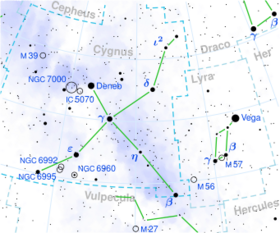Astronomy:Xi Cygni
From HandWiki
Short description: Star in the constellation Cygnus
| Observation data Equinox J2000.0]] (ICRS) | |
|---|---|
| Constellation | Cygnus |
| Right ascension | 21h 04m 55.874s[1] |
| Declination | +43° 55′ 40.285″[1] |
| Apparent magnitude (V) | 3.73[2] |
| Characteristics | |
| Spectral type | K4:Ib- + A1.5V[3] |
| U−B color index | +1.78[2] |
| B−V color index | +1.66[2] |
| Astrometry | |
| Radial velocity (Rv) | -19.10[4] km/s |
| Proper motion (μ) | RA: +9.763[5] mas/yr Dec.: +0.646[5] mas/yr |
| Parallax (π) | 3.59 ± 0.45[5] mas |
| Distance | approx. 900 ly (approx. 280 pc) |
| Absolute magnitude (MV) | −4.3/+1.3[3] |
| Orbit[6] | |
| Period (P) | 6,750 ± 200 days |
| Semi-major axis (a) | ~766 R☉ |
| Eccentricity (e) | 0.25 ± 0.07 |
| Inclination (i) | ~50° |
| Details | |
| Primary | |
| Mass | ~8[6] M☉ |
| Radius | 174[1] R☉ |
| Luminosity | 6,081 - 6,368[1] L☉ |
| Surface gravity (log g) | 1.00[7] cgs |
| Temperature | 3,898±170[1] K |
| Metallicity [Fe/H] | −0.41[7] dex |
| Secondary | |
| Mass | ~2.5[6] M☉ |
| Other designations | |
62 Cygni, FK5 792, GC 29459, HIP 104060, HR 8079, HD 200905, SAO 50424 | |
| Database references | |
| SIMBAD | data |
ξ Cygni (Latinised as Xi Cygni) is a spectroscopic binary star in the constellation Cygnus. Its apparent magnitude is 3.73 and it is located around 360 parsecs (1,200 ly) away.
The system contains two stars which orbit every 18 years in a mildly eccentric orbit. The primary star is a supergiant with a spectral type of around K4, while the secondary is an A-type main-sequence star with a spectral type of A1.5. Stellar winds from the supergiant have been measured at around 50 km/s, but with variations in speed and individual line strengths.[6]
ξ Cygni is in the Kepler spacecraft's field of view but no planets have been detected.[8]
-
H-alpha RGB amateur image of ξ Cygni, center star, at edge of NGC7000
-
NGC 7000 (North America Nebula). ξ Cygni is the bright star on the left.
References
- ↑ 1.0 1.1 1.2 1.3 1.4 Messineo, M.; Brown, A. G. A. (2019). "A Catalog of Known Galactic K-M Stars of Class I Candidate Red Supergiants in Gaia DR2". The Astronomical Journal 158 (1): 20. doi:10.3847/1538-3881/ab1cbd. Bibcode: 2019AJ....158...20M.
- ↑ 2.0 2.1 2.2 Ducati, J. R. (2002). "VizieR Online Data Catalog: Catalogue of Stellar Photometry in Johnson's 11-color system". CDS/ADC Collection of Electronic Catalogues 2237: 0. Bibcode: 2002yCat.2237....0D.
- ↑ 3.0 3.1 Ginestet, N.; Carquillat, J. M. (2002). "Spectral Classification of the Hot Components of a Large Sample of Stars with Composite Spectra, and Implication for the Absolute Magnitudes of the Cool Supergiant Components". The Astrophysical Journal Supplement Series 143 (2): 513. doi:10.1086/342942. Bibcode: 2002ApJS..143..513G.
- ↑ Famaey, B. et al. (January 2005), "Local kinematics of K and M giants from CORAVEL/Hipparcos/Tycho-2 data. Revisiting the concept of superclusters", Astronomy and Astrophysics 430 (1): 165–186, doi:10.1051/0004-6361:20041272, Bibcode: 2005A&A...430..165F
- ↑ 5.0 5.1 5.2 Brown, A. G. A. (August 2018). "Gaia Data Release 2: Summary of the contents and survey properties". Astronomy & Astrophysics 616: A1. doi:10.1051/0004-6361/201833051. Bibcode: 2018A&A...616A...1G. Gaia DR2 record for this source at VizieR.
- ↑ 6.0 6.1 6.2 6.3 Reimers, D.; Schroeder, K.-P. (1989). "Observations of modulation and phase displacement of the stellar wind in six red giant spectroscopic binaries". Astronomy and Astrophysics 214: 261. Bibcode: 1989A&A...214..261R.
- ↑ 7.0 7.1 Hekker, S.; Meléndez, J. (2007). "Precise radial velocities of giant stars. III. Spectroscopic stellar parameters". Astronomy and Astrophysics 475 (3): 1003. doi:10.1051/0004-6361:20078233. Bibcode: 2007A&A...475.1003H.
- ↑ Molenda-Żakowicz, J.; Sousa, S. G.; Frasca, A.; Uytterhoeven, K.; Briquet, M.; Van Winckel, H.; Drobek, D.; Niemczura, E. et al. (2013). "Atmospheric parameters of 169 F-, G-, K- and M-type stars in the Kepler field". Monthly Notices of the Royal Astronomical Society 434 (2): 1422. doi:10.1093/mnras/stt1095. Bibcode: 2013MNRAS.434.1422M.
 |



